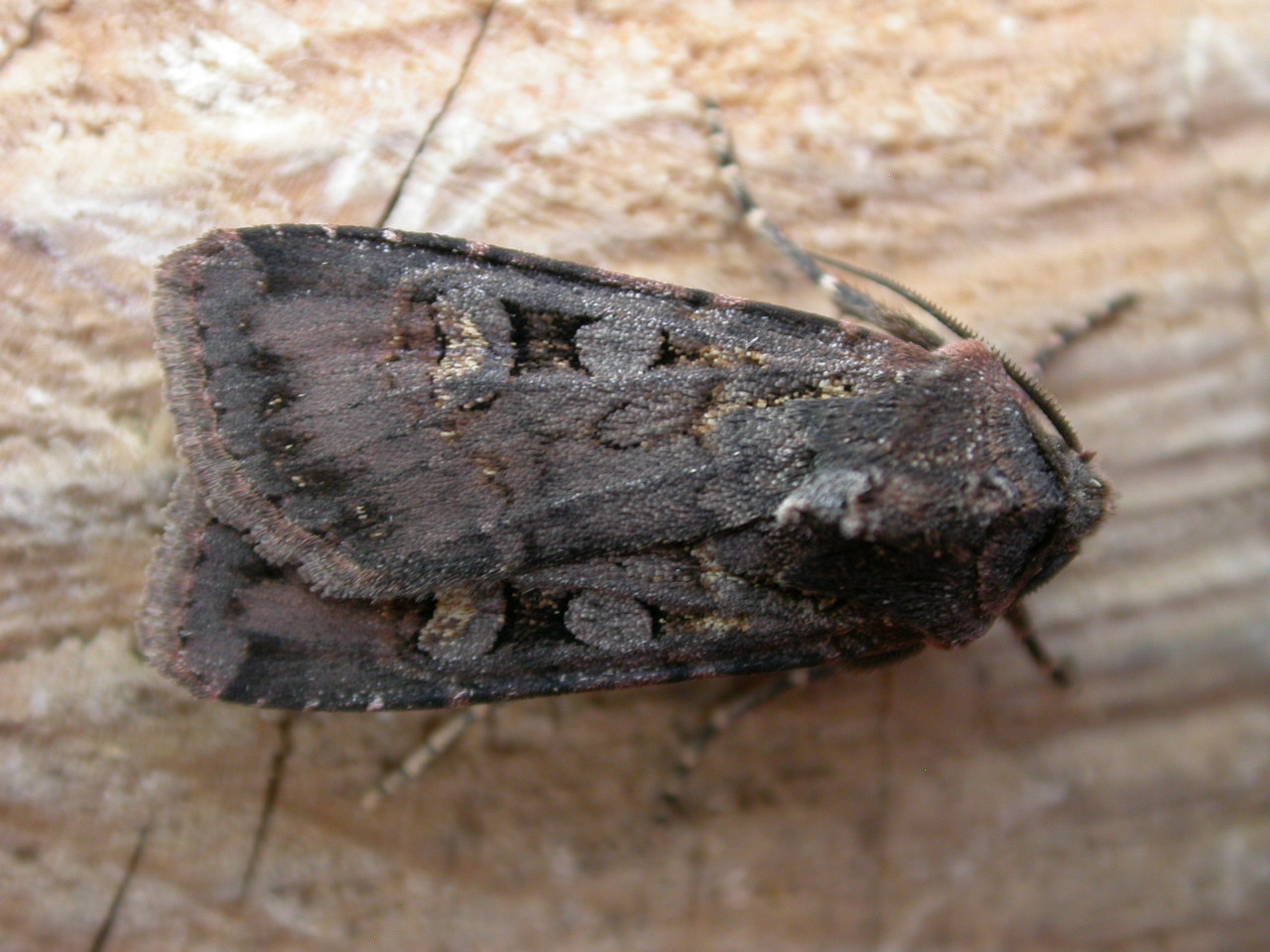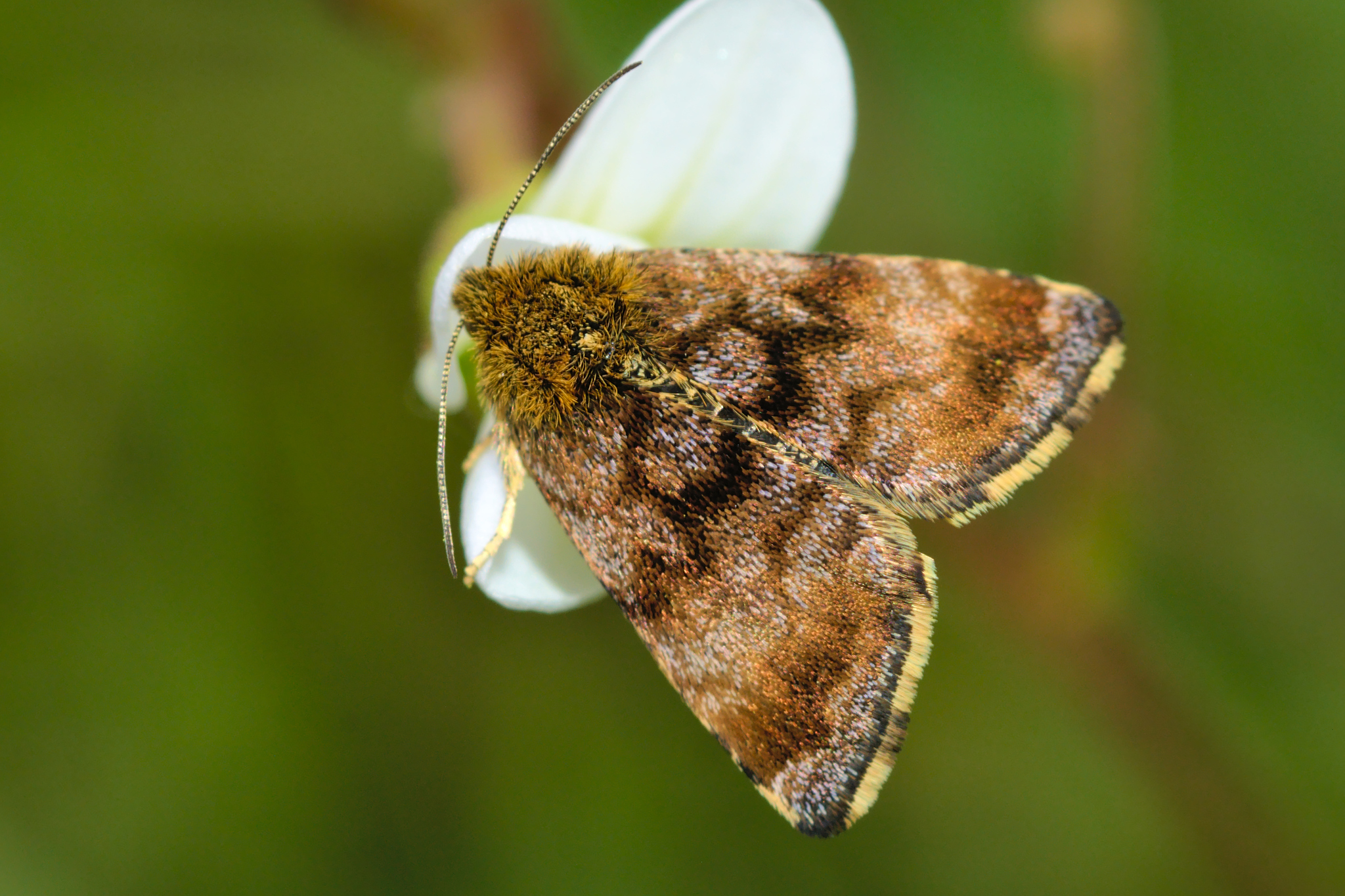|
Noctuid Moth
The Noctuidae, commonly known as owlet moths, cutworms or armyworms, are a family of moths. Taxonomically, they are considered the most controversial family in the superfamily Noctuoidea because many of the clades are constantly changing, along with the other families of the Noctuoidea. It was considered the largest family in Lepidoptera for a long time, but after regrouping Lymantriinae, Catocalinae and Calpinae within the family Erebidae, the latter holds this title now. Currently, Noctuidae is the second largest family in Noctuoidea, with about 1,089 genera and 11,772 species. This classification is still contingent, as more changes continue to appear between Noctuidae and Erebidae. Description Adult: Most noctuid adults have wings with a variety of shades of browns, grays, and other varied shades and colourations but some subfamilies, such as Acronictinae and Agaristinae, are very colorful, especially those from tropical regions (e.g. '' Baorisa hieroglyphica''). They are ch ... [...More Info...] [...Related Items...] OR: [Wikipedia] [Google] [Baidu] |
Amphipoea Oculea
''Amphipoea oculea'', the ear moth, is a moth of the family Noctuidae. It was first described by Carl Linnaeus in 1761 and it is found in most of the Palearctic realm. It is widespread and common in southern England, and also occurs in Ireland and throughout continental Europe, with the exception of Albania, Greece and Turkey. It is one of four species that are difficult to tell apart, requiring the examination of the genitalia. The larvae feed in the stems and roots of low plants and grasses. Description The wingspan is 29–34 mm. Forewing pale or dark ferruginous brown; the veins brown; inner and outer lines double, brown, wide apart; the inner curved outwards between, and toothed inwards on, the veins; the outer with the inner arm thin, lunulate-dentate, the outer thick, continuous and parallel; a thick dark median shade running between the stigmata; submarginal line indistinct, waved, angled on vein 7, above which it is preceded by a dark costal patch; orbicular stigm ... [...More Info...] [...Related Items...] OR: [Wikipedia] [Google] [Baidu] |
Cutworm
Cutworms are moth larvae that hide under litter or soil during the day, coming out in the dark to feed on plants. A larva typically attacks the first part of the plant it encounters, namely the stem, often of a seedling, and consequently cuts it down; hence the name ''cutworm''. Cutworms are not worms, biologically speaking, but caterpillars. Feeding and hiding Cutworm larvae vary in their feeding behaviour; some remain with the plant they cut down and feed on it, while others often move on after eating a small amount from a felled seedling; such a wasteful mode of feeding results in disproportionate damage to crops. Cutworms accordingly are serious pests to gardeners in general, but to vegetable and grain farmers in particular. For example, it has been suggested that in South Africa, ''turnip moth, Agrotis segetum'' is the second worst pest of maize.Smit, Bernard, "Insects in South Africa: How to Control them", Pub: Oxford University Press, Cape Town, 1964. Note that the cutwor ... [...More Info...] [...Related Items...] OR: [Wikipedia] [Google] [Baidu] |
Stiriinae
Stiriinae is a subfamily of owlet moths in the family Noctuidae. There are more than 20 genera and 130 described species in Stiriinae. The current classification of Stiriinae is based on phylogenetic research published in 2019 in which the tribe Stiriini was determined to be polyphyletic, with much of its diversity spread among three subfamilies, and a follow-up study in 2021 that found (at the time) non-Stiriinae genera grouped within Stiriinae in phylogenetic analyses. As a result of these studies, the tribe Stiriini was elevated to subfamily status as Stiriiinae, Grotellina, a subtribe of Stiriini before the 2019 study, was elevated to subfamily status as Grotellinae, and various other genera that were found to group in the closely related subfamily Metoponiinae were transferred into it. Stiriini and Annaphilini are now tribes of the currently recognized Stiriinae (with no subtribes within either) containing the majority of genera from the former subtribes Stiriina and Annap ... [...More Info...] [...Related Items...] OR: [Wikipedia] [Google] [Baidu] |
Raphiinae (moth)
''Raphia'' is a genus of moths of the family Noctuidae The Noctuidae, commonly known as owlet moths, cutworms or armyworms, are a family (biology), family of moths. Taxonomically, they are considered the most controversial family in the superfamily Noctuoidea because many of the clades are constantly .... It is the only genus under subfamily Raphiinae. They occur in southern Europe, temperate Asia, and North America. Species * '' Raphia aethiops'' * '' Raphia approximata'' * '' Raphia corax'' * '' Raphia frater'' Grote, 1864 * '' Raphia hybris'' Hübner, 1813 * '' Raphia illarioni'' * '' Raphia obsoleta'' * '' Raphia peusteria'' Püngeler, 1907 References Natural History Museum Lepidoptera genus database Noctuidae Taxa named by Jacob Hübner {{Raphiinae-stub ... [...More Info...] [...Related Items...] OR: [Wikipedia] [Google] [Baidu] |
Plusiinae
Plusiinae is a smallish (for noctuid standards) subfamily of the moth family Noctuidae. As the Noctuidae appear to be a paraphyletic assemblage, the Plusiinae may eventually be raised to family status (Weller ''et al.'' 1994). Comparison of Eurasian species Image:Autographa aemula.jpg, '' Autographa aemula'' Image:Autographa bractea.jpg, '' Autographa bractea'' Image:Autographa excelsa 01.jpg, '' Autographa excelsa'' Image:Autographa gamma.o1.jpg, '' Autographa gamma'' Image:Autographa mandarina 1.jpg, '' Autographa mandarina'' Image:Autographa macrogamma 01.JPG, '' Autographa macrogamma'' Image:Autographa nigrisigna.jpg, '' Autographa nigrisigna'' Image:Autographa buraetica 01.jpg, '' Autographa buraetica'' Image:Autographa pulchrina.jpg, '' Autographa pulchrina'' Image:Autographa jota.jpg, '' Autographa jota'' Image:Ctenoplusia limbirena.jpg, '' Ctenoplusia limbirena'' Image:Euchalcia taurica.jpg, '' Euchalcia taurica'' Image:Euchalcia consona.jpg, '' Euchalcia consona'' Image: ... [...More Info...] [...Related Items...] OR: [Wikipedia] [Google] [Baidu] |
Pantheinae ''
* '' Pantheaforma''
*'' Pseudopanthea''
*'' Smilepholcia''
*'' Pantheinae is a small subfamily of moth family Noctuidae. It used to be considered a family, under the name Pantheidae. Genera *'' Anacronicta'' *'' Anepholcia'' *'' Bathyra'' *'' Brandtina'' *'' Charadra'' *''Colocasia'' *'' Disepholcia'' *'' Elydnodes'' *'' Gaujonia'' * '' Lafontaineana'' *'' Lichnoptera'' *'' Meleneta'' *''Moma'' *'' Panthauma'' *''Panthea ''Panthea'' is a genus of the owlet moth family, Noctuidae. The word ''Panthea'' is from Greek, meaning "all of gods" . [...More Info...] [...Related Items...] OR: [Wikipedia] [Google] [Baidu] |
Oncocnemidinae
Oncocnemidinae is a subfamily of moths which belong to the large moth family (Noctuidae). In contrast to most other members of the family, they fly during the day. Oncocnemidinae are small, dark coloured moths, but the backs of their wings are generally white with broad, black stripes. Systematic classification * Subfamily Oncocnemidinae ** '' Calophasia'' ***'' Calophasia lunula'' (Hufnagel, 1766) **'' Sympistis'' Hübner, 1823 ***'' Sympistis funebris'' (Hübner, 1809) ***'' Sympistis heliophila'' (Paykull, 1793) ***'' Sympistis lapponica'' (Thunberg, 1791) ***'' Sympistis nigrita'' (Boisduval, 1840) **'' Calliergis'' (Hübner, 1821) ***'' Calliergis ramosa'' (Esper, 1786) **''Stilbia ''Stilbia'' is a genus of moths of the family Noctuidae. Species * ''Stilbia algirica'' Culot, 1914 * ''Stilbia andalusiaca'' Staudinger, 1892 * ''Stilbia anomala'' (Haworth, 1812) * ''Stilbia bongiovanni'' Turati, 1924 * ''Stilbia calberlae'' ( ...'' (Stephens, 1829) ***'' Stilbia anomala'' ... [...More Info...] [...Related Items...] OR: [Wikipedia] [Google] [Baidu] |
Noctuinae
The Noctuinae are a subfamily of the family Noctuidae, and is composed of moths. The larvae of many species feed on roots or stems of various grasses. Some are generalist feeders which makes them potential pests. Noctuid systematics is in a state of flux; the list of tribes is provisional and other groups now considered more distinct (e.g. Hadeninae Hadeninae was formerly a subfamily of the moth family Noctuidae, but was merged into the subfamily Noctuinae. The tribes Apameini, Caradrinini, Elaphriini, Episemini, Eriopygini The Eriopygini are a small-sized tribe of moths in the Noctui ...) were formerly included here. Likewise, the validity of the tribe Xestiini is doubtful for example. See also * List of Noctuinae genera References * Moth subfamilies {{Noctuinae-stub ... [...More Info...] [...Related Items...] OR: [Wikipedia] [Google] [Baidu] |
Metoponiinae
Metoponiinae is a subfamily of owlet moths in the family Noctuidae The Noctuidae, commonly known as owlet moths, cutworms or armyworms, are a family (biology), family of moths. Taxonomically, they are considered the most controversial family in the superfamily Noctuoidea because many of the clades are constantly .... There are about 16 genera and more than 70 described species in Metoponiinae. Genera These 16 genera belong to the subfamily Metoponiinae: * '' Aegle'' Hübner, 1823 * '' Axenus'' Grote, 1873 * '' Azenia'' Grote, 1882 * '' Cydosia'' Duncan & Westwood, 1841 * '' Epharmottomena'' John, 1909 * '' Flammona'' Walker, 1863 * '' Haemerosia'' Boisduval, 1840 * '' Metaponpneumata'' Möschler, 1890 * '' Metopoplus'' Christoph, 1893 * '' Mycteroplus'' Herrich-Schaffer, 1850 * '' Panemeria'' Hübner, 1823 * '' Pinacoplus'' Hampson, 1910 * '' Proschaliphora'' Hampson, 1901 * '' Sexserrata'' Barnes & Benjamin, 1922 * '' Synthymia'' Hübner, 1823 * '' Tristyla'' Smith, 1893 ... [...More Info...] [...Related Items...] OR: [Wikipedia] [Google] [Baidu] |
Heliothinae
Heliothinae is a small, cosmopolitan subfamily of moths in the family Noctuidae, with about 400 described species worldwide. It includes a number of economically significant agricultural pest species, such as '' Helicoverpa armigera'' and ''Helicoverpa zea''. Taxonomy The subfamily has been studied extensively. Important works include studies by Hardwick (1965 and 1970) and Matthews (1988). Distribution and diversity Heliothinae is a cosmopolitan subfamily of around 400 species. Its species thrive in hot, dry regions of the world, and the subfamily has its highest species diversity in seasonally-arid tropics and subtropics, such as those found Australia, sections of Asia, the southwest region of the United States, and Africa. Larvae The subfamily includes both specialist species, of which the larvae feed on only a limited range of plants, and polyphagous generalist species. The subfamily contains several agricultural pests, including '' Helicoverpa armigera'', '' Helicoverpa ... [...More Info...] [...Related Items...] OR: [Wikipedia] [Google] [Baidu] |
Grotellinae
Grotellinae is a subfamily of owlet moths in the family Noctuidae. There are about 5 genera and more than 20 described species in Grotellinae. They are found primarily in North and Central America, and are common in the southwestern United States. As a result of phylogenetic research published in 2019, the subfamily Grotellinae was established when Grotellina, a subtribe of Stiriini, was elevated in rank to subfamily. Genera These five genera belong to the subfamily Grotellinae: * ''Grotella ''Grotella'' is a genus of moths of the family Noctuidae Species description, first described by Leon F. Harvey in 1875. Species * ''Grotella binda'' Barnes, 1907 * ''Grotella blanca'' Barnes, 1904 * ''Grotella blanchardi'' McElvare, 1966 * ''Gr ...'' Harvey, 1875 * '' Grotellaforma'' Barnes & Benjamin, 1922 * '' Hemigrotella'' Barnes & McDunnough, 1918 * '' Neogrotella'' Barnes & Benjamin, 1922 * '' Podagra'' Smith, 1902 References Noctuidae {{noctuidae-stub ... [...More Info...] [...Related Items...] OR: [Wikipedia] [Google] [Baidu] |



